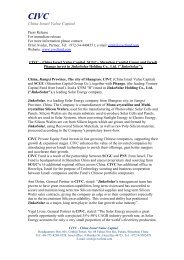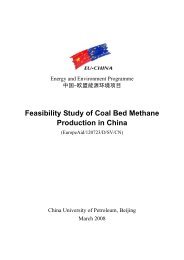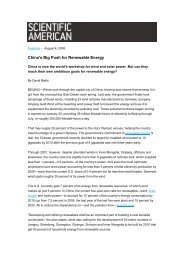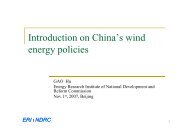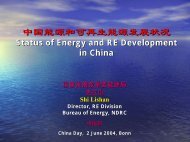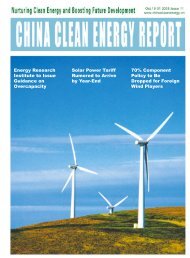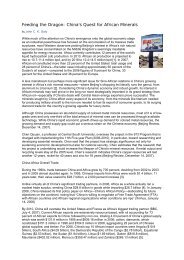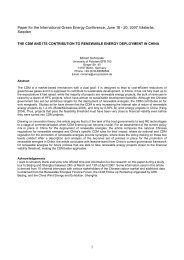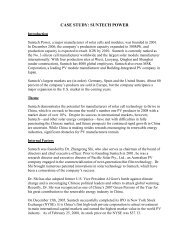LDK Solar Co., Ltd. - Asia Europe Clean Energy (Solar) Advisory Co ...
LDK Solar Co., Ltd. - Asia Europe Clean Energy (Solar) Advisory Co ...
LDK Solar Co., Ltd. - Asia Europe Clean Energy (Solar) Advisory Co ...
Create successful ePaper yourself
Turn your PDF publications into a flip-book with our unique Google optimized e-Paper software.
polysilicon prices will decline in the long run, we expect that our manufacturing costs as a percentage of our<br />
cost of goods sold will become more significant. Since our inception, we have taken a series of measures to<br />
reduce our manufacturing costs, through increased production scale, improved production yield, using<br />
automatic sorting equipment to reduce wafer breakage, and more skilled manufacturing personnel following<br />
their initial learning curve. If we fail to continue to reduce our manufacturing costs, our profitability will be<br />
adversely affected.<br />
Pricing of our products<br />
Our wafer prices are based on a variety of factors, including global market wafer prices, supply and<br />
demand conditions in China, which is our largest market, and the terms of our customer contracts, including<br />
sales volumes and the terms on which certain customers supply us with polysilicon. We price our wafers on a<br />
per-piece basis. According to Photon <strong>Co</strong>nsulting, wafer prices on a per-watt basis are expected to decline in<br />
the next few years due to increased production efficiencies, expected increases in global polysilicon supplies<br />
and declines in polysilicon prices, and increased wafer production capacity in our industry, and we expect the<br />
average selling price of our wafers to decline in 2007 and thereafter. If wafer prices decline and we are unable<br />
to lower our costs in line with the price decline, whether through manufacturing larger ingots or thinner<br />
wafers, or through technological advances, our gross margins would be adversely affected. In addition, as a<br />
part of our geographic expansion strategy, we plan to significantly expand our overseas sales in 2007 and future<br />
years to target the top 20 solar cell and module manufacturers in the world to strengthen our long-term<br />
customer base. The current prevailing international market price for solar wafers is lower than the prevailing<br />
PRC market price. As a result, our increase in overseas sales may reduce our gross margin in the near term.<br />
Net Sales<br />
We derive revenues primarily from the sale of multicrystalline wafers. We also sell a small number of<br />
monocrystalline wafers. We provide wafer processing services to customers who supply silicon materials<br />
and/or multicrystalline or monocrystalline ingots to us for processing into wafers. The silicon materials we sell<br />
include multicrystalline ingots as well as silicon scraps. In the year ended December 31, 2006, our net sales<br />
were generated almost entirely from the sale of wafers, which accounted for 97.2% of our net sales. Sale of<br />
silicon materials and wafer processing services accounted for 2.4% and 0.4%, respectively, of our net sales<br />
during the year ended December 31, 2006. During the three months ended March 31, 2007, approximately<br />
83.5% of our net sales were generated from sales of multicrystalline wafers and 7.4% from sales of<br />
monocrystalline wafers. Sales of silicon materials and wafer processing services accounted for 3.2% and 5.9%,<br />
respectively, of our net sales during the three months ended March 31, 2007. We expect that sales of<br />
multicrystalline wafers will continue to account for a majority of our net sales for the foreseeable future. We<br />
also expect that our net sales will increase as we expand our production capacity to meet the market demand.<br />
Our net sales are affected by our unit sales volume and average selling prices. We currently make most of<br />
our sales to customers through non-exclusive, short-term purchase order arrangements. Increased sales on a<br />
contract rather than spot market basis are likely to lead to a reduction in average selling prices. We have<br />
entered into long-term sales arrangements with some of our major customers, including CSI, <strong>Solar</strong>fun,<br />
Solland <strong>Solar</strong> and Suntech. We have also entered into sales arrangements with BP <strong>Solar</strong>, E-Ton, GE <strong>Energy</strong>,<br />
Motech, Q-Cells and other customers. In the year ended December 31, 2006, our top five customers<br />
accounted for 70.2% of our net sales. Suntech and <strong>Solar</strong>fun contributed 39.7% and 13.9%, respectively, of our<br />
net sales for the same period. During the three months ended March 31, 2007, our top five customers<br />
accounted for 56.8% of our net sales. Suntech and <strong>Solar</strong>fun contributed 18.3% and 9.7%, respectively, of our<br />
net sales for the three-month period. Chinalight contributed 13.6% of our net sales for the three-month period<br />
ended March 31, 2007. We do not have long-term arrangements with Chinalight and our sales to Chinalight<br />
have been based on short-term sales contracts and monthly and quarterly purchase orders.<br />
44



